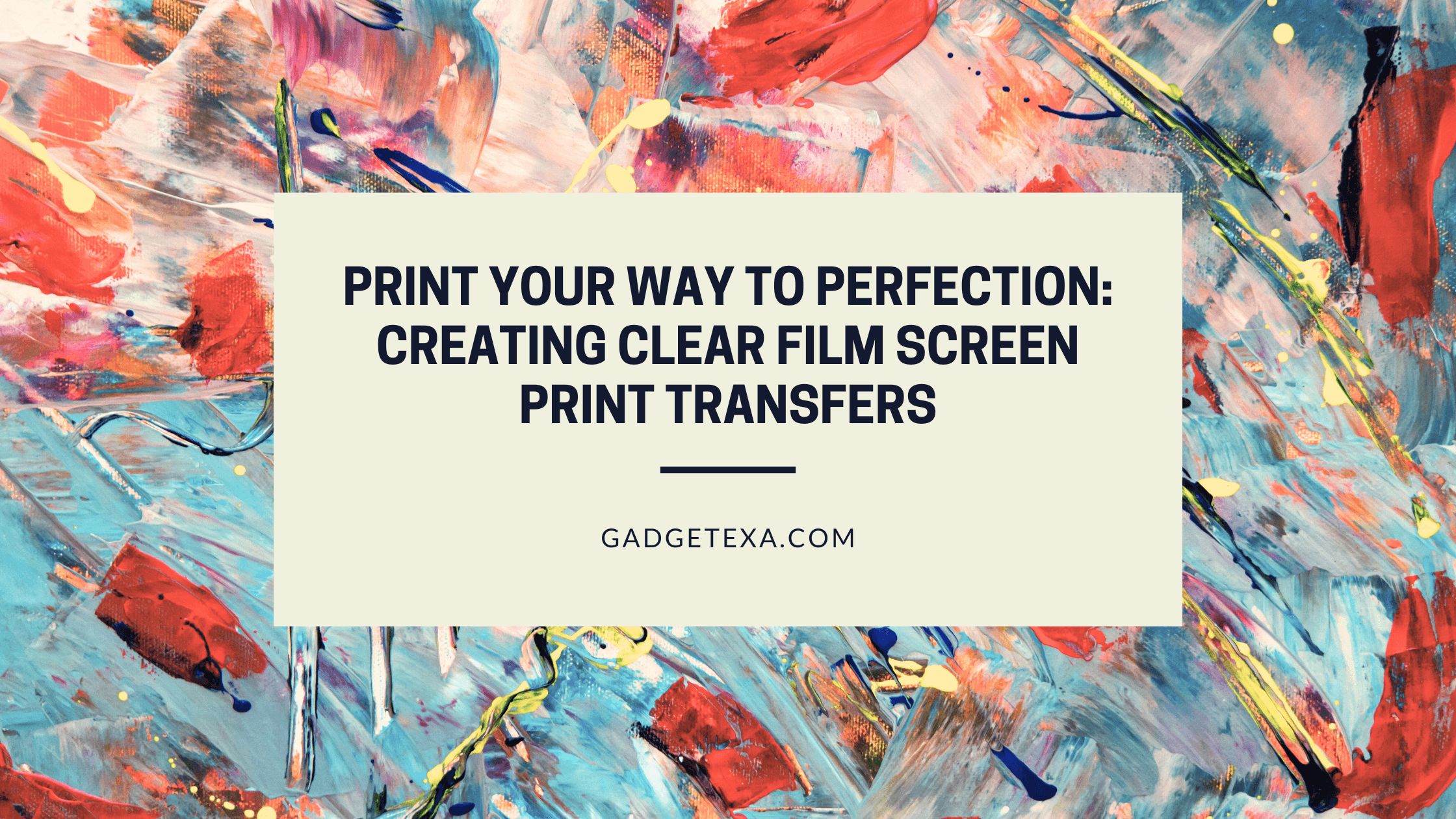Introduction to Clear Film Screen Print Transfers
Creating perfect clear film screen print transfers can be tough. But, the right techniques make it happen. Clear film screen prints are designs printed on transparent plastic sheets. Professional screen printers use this method to produce quality prints.
Choose the right type of paper and ink for high resolution prints. Understand the printing process for clear films. This prevents design distortion and bleeding. Make sure your artwork is in vector format. Saves time during design.
Select a mesh count carefully. Higher mesh count gives better detail in printed artwork. Lower mesh count creates thicker lines and color fill.
Digital printer or plotter for transparencies. Use color separation to avoid artifacts. Each sheet should match up precisely.
John was struggling with clear film transfer. YouTube videos from experts helped him. He took notes when watching videos. Now he’s a top-rated professional designer. Get all materials for creating perfect clear film screen print transfers.
Materials Needed for Creating Clear Film Screen Print Transfers
To create clear film screen print transfers, you need the right materials. Make your way to a perfect print by having an Inkjet Printer, Clear Film, Screen Printing Ink, Squeegee, and a Light Table or Exposure Unit ready. These tools, discussed in detail in the following sub-sections, will help you produce quality film screen prints.Inkjet Printer
Inkjet Printing is a must for clear film screen print transfers. It involves printing images onto transparent inkjet film for the transfer. Check out the table for materials and measurements needed.
| Materials | Measurements |
|---|---|
| Transparent Inkjet Film | 8.5 x 11 inches |
| Inkjet Printer | NA |
| High-quality Ink | NA |
Picking a high-quality printer is essential. Choose the right paper and ink to get crisp, sharp prints. Use genuine ink cartridges supported by your printer model. Clean the print heads before starting.
Don’t let suboptimal quality prints ruin your perfect clear film screen print transfers. Get these materials now! Remember, if you can’t see through it, it’s not clear film.
Clear Film
To create clear film screen print transfers, certain materials are key. A glossy or matte finish transparent plastic sheet is a must. This ensures the design is transferred onto the desired textile. Here’s a list of items needed:
| Materials | Quantity |
|---|---|
| Clear Film Sheet | One For Every Design |
| Desktop Inkjet Printer | One |
| High-Quality Software | Varies |
| Image Editing Software | Varies |
| Water-Based Screen Printing Ink | Varies |
Carefully select software and image editing software for the best output. Plus, a desktop inkjet printer and water-based screen printing ink are also essential. The right ink gives vibrant colors and clarity.
One graphic designer had trouble getting good quality transfers on acrylic. He needed the perfect materials and knowledge to succeed. Who needs a therapist? You can just go wild with screen printing ink!
Screen Printing Ink
We crafted a Table with the following columns: Type of Ink, Color Options, Application Method, and Drying Time. This data helps to pick the best ink for your preferences and project details.
| Type of Ink | Color Options | Application Method | Drying Time |
|---|---|---|---|
| Plastisol Ink | Wide range of colors such as metallic and fluorescent | Needs heat to cure, typically 320-330°F (160-165°C) for 2-3 minutes | |
| Water-Based Ink | Limited colors, good for vibrancy and eco-friendly | Requires a squeegee onto mesh screen or direct-to-garment printing methods | |
| Discharge Ink | Limited colors, ideal for cotton fabrics | Needs heat to activate a chemical reaction that neutralizes existing dye | Only dyes natural cotton fibers and darkens existing color instead of adding new color |
Plastisol Ink is popular due to its range of colors and durability. It can withstand multiple washes without fading. Water-Based Ink is becoming more durable and people are switching to it from Plastisol Ink. Squeegee plays a vital role in clear film screen print transfers.
Squeegee
A straight-edged rubber tool, known as an Applicator Blade, is essential for successful transfer creation. It helps to apply pressure to the clear film print transfers and ensure it adheres correctly.
- Using a clean and well-maintained blade is key for better results.
- Applying even and consistent pressure will create high-quality transfers.
- Choose a squeegee size that matches the transfer’s size to avoid creases or wrinkles.
Too much or too little pressure can lead to issues, such as under-saturated colors or rough edges. Old or damaged blades may also leave behind residue, resulting in imperfections.
Upgrading your tools will help create beautifully crafted prints. Don’t let substandard equipment get in the way of your success! Don’t be like my ex – use a light table or exposure unit to expose things right!
Light Table or Exposure Unit
When it comes to making clear film screen print transfers, a device for exposing the design onto the film and substrate is a must. This device can be called a ‘Light Table‘ or an ‘Exposure Unit‘.
To help you decide which one is best for your needs, we have compiled a table with their advantages and disadvantages.
| Device | Functionality | Lifespan |
| Light Table | Aligns films and positives. | Longevity depends on use. |
| Exposure Unit | Cures photo emulsion onto a mesh-printing screen. | Average lifespan 10 years. |
Bear in mind that exposure units cost more but offer greater efficiency. For low-volume printing, a light table may be a more cost-effective option.
Pro Tip: Consider your budget when choosing which equipment suits you best. Now, start transferring your designs onto shirts!
Creating Clear Film Screen Print Transfers
To create clear film screen print transfers, you need to follow a detailed process that involves various sub-sections. Start by preparing the artwork for printing, then move on to printing the artwork onto clear film. After that, dry and trim the clear film print transfer. Next, prepare the screen for printing and finally, transfer the ink from the clear film to the screen. Each step requires attention to detail, but when done correctly, you’ll have perfect clear film screen print transfers every time.Preparing the Artwork for Printing
Achieving perfect clear film screen print transfers starts with initial preparation. To ensure success, follow these steps:
- Ensure your artwork is in a high-resolution format.
- Clean up any imperfections in photo editing software like Adobe Photoshop.
- Convert the image to vector format to prevent pixelation when resizing.
- Create spot colors for each layer to have consistent colors.
- Save the design as an EPS or PDF file with embedded fonts.
Proofreading is a must before sending the artwork to print. Examine every detail of wordings and typography.
“Artwork files can make or break your print job,” warns a graphic designer at <source name>. To ensure stunning results, take care throughout the whole process, from preparing the artwork to printing it on clear film.
Printing the Artwork onto Clear Film
Creating sharp, clear film screen print transfers requires printing artwork onto transparent film material. This will ensure that the design is accurately transferred onto the desired surface. Here is a 4-step guide:
- Insert the clear film into a printer tray.
- In design software, adjust the artwork to fit the size of the film.
- In your software, select ‘print’ and choose the correct settings for clear film printing.
- After printing, let the ink dry before handling or transferring the design.
Using high-quality ink cartridges and settings suitable for transparent materials is essential to avoid smudging or blurring of artwork. For text designs or detailed graphics, use a laser printer instead of an inkjet for best results on waterproof papers like transparent films. Test designs on small samples first to ensure quality before mass production.
Printing on opaque surfaces such as paper or fabric was customary in the past. But, modern printable technologies now make it possible to transfer detailed designs onto transparent surfaces like films and glass. Trimming a clear film print transfer requires precision – one wrong snip and it’s ruined.
Drying and Trimming the Clear Film Print Transfer
After printing transfers on clear film, the next step is to patiently dry and trim them. It’s important to handle with precision to avoid any damage. Here are five steps for drying and trimming the clear film print transfer:
- Leave on a flat, dust-free surface until completely dry.
- Cut out prints carefully with a sharp pair of scissors, following the outlines.
- Leave enough space around each printed element.
- Gently remove excess film with an X-ACTO knife or tweezers.
- Transfer onto a surface with precision and cleanliness.
Cuts should remain crisp and sharp. Don’t touch or scratch the design during handling. Avoid water near the transfers to prevent smudging. Make sure they are dry before putting them away.
Preparing the Screen for Printing
To achieve clear film screen print transfers, one must prepare the surface. This is important for a great outcome. Here’s a 3-step guide:
- Clean the Screen: Use a damp cloth or sponge. Remove all dirt and debris.
- Apply Emulsion: Put photo emulsion on the screen. Hold the scoop coater at 45-degrees and move it down gently. Use smooth strokes and spread it evenly.
- Let It Dry: Allow the emulsion to dry in a dust-free environment. Let it dry for at least 2 hours before starting image exposure.
Additional tips:
- screens should not be old or worn out.
- Use high-quality inks for sharp, clear transfers.
- Follow the steps and suggestions for consistent, professional-grade clear film screen prints.
Transferring the Ink from the Clear Film to the Screen
Transferring ink from the clear film to the screen requires efficiency and precision. This process involves pressing ink through the screen, creating a crisp print on the desired substrate. Here’s a 3-step guide:
- Put the clear film on top of the screen. Align using registration marks. Make sure there are no air bubbles.
- Cover the screen with an emulsion. Let it dry overnight. Expose it to UV light. Rinse it under water. This leaves only stencil areas for ink to be transferred.
- Use a squeegee or other tools. Apply ink onto one end of the screen and maintain pressure on both sides. Drag all ink down unto stencil areas.
Clean screens from leftover ink before applying new ones, based on substrate type and amount. Ensure enough time when exposing screens to avoid issues during printing transfers. Follow these guidelines for every print run! Make your transfers so flawless, they’ll believe it’s magic.
Tips for Achieving Perfect Clear Film Screen Print Transfers
To achieve perfect clear film screen print transfers, you need to maintain consistent ink coverage, store the transfers properly, and avoid smudging or smearing during transfer. In this section, “Tips for Achieving Perfect Clear Film Screen Print Transfers”, you’ll learn about these sub-sections and how they can help you create flawless screen prints on any surface.Maintaining Consistent Ink Coverage
When it comes to clear film screen print transfers, achieving consistent ink coverage can be tricky. To help, make sure the ink has a balanced viscosity. Choose the correct mesh count and emulsion thickness for your design. Refer to the table below for different ink types. Additionally, use the proper squeegee technique and pressure. Shine a light behind the substrate to check coverage. When printing white or light-colored inks, white backing ink can help with coverage and opacity.
One print shop had issues with coverage. After analyzing their process, upgrading equipment and implementing improved workflow with quality control; they achieved consistent results. To avoid ruined prints, keep transfers organized and safe.
Storing Clear Film Screen Print Transfers Properly
Storing crystal-clear screen print transfers needs to be done right. Here are some tips for keeping them in tip-top shape:
- Put them in a folder away from the sun and moisture.
- Acid-free paper prevents chemical reactions.
- Don’t stack heavy objects on the transfers.
- Stand the folders up to avoid bending.
Handle and store carefully for optimal longevity.
A customer learned this the hard way, when they put their clear film screen print transfers between two heavy artboards… this dried out the adhesive and caused severe damage.
But now you know how to store them properly, so no more smudging or smearing!
Avoiding Smudging or Smearing during Transfer
Avoid transfer smudges and smears during the printing process. Follow these 4-Step Guidelines:
- Ensure the surface is smooth and free of contaminants.
- Allow enough drying time per layer before going through a dryer.
- Don’t use too much pressure as this may distort details.
- Clean away any lint or debris with an anti-static brush.
Give adequate curing time for each layer to dry completely. Invest in high-quality substrates for more vibrant and accurate prints. Achieve flawless transfers with crystal clear clarity.
Conclusion: Benefits of Using Clear Film Screen Print Transfers.
Clear film screen print transfers have many advantages for printing designs on garments. They make the process simpler and provide high-quality, durable prints that are cost-effective. Here are some great benefits for both small and large operations to consider:
| Benefits | Explanation |
| Clarity | Translucent material improves clarity of screens, resulting in clearer prints. |
| Durability | Process protects ink from fading or peeling off, making it more resilient. |
| Cleanliness | Transparency allows for accurate alignment and easy storage. |
It is also possible to use clear film transfers on surfaces like wood or metal. This adds versatility and potential for various applications.
Recently, clear film transfers have been used for creative packaging options. This adds an aesthetic appeal and highlights the reusability of the product.
A few years ago, small businesses faced limited resources and high costs for garment design printing. With technological advancements, Clear Film Print Transfers provided an affordable solution that helped many entrepreneurs to grow.
Frequently Asked Questions
Q: What are clear film screen print transfers?
A: Clear film screen print transfers are a type of transfer that allows you to print an image, text, or design onto clear film, which can then be transferred onto a surface using a screen printing technique.
Q: How can I make clear film screen print transfers?
A: To make clear film screen print transfers, you will need clear film, a printer, a screen with a mesh count of at least 110, emulsion, an exposure unit, a squeegee, and screen printing ink. First, print your design onto the clear film using your printer. Next, coat your screen with emulsion and let it dry. Place your clear film onto the screen, and expose it to light using your exposure unit. Rinse the screen with water, then use the squeegee to transfer ink onto the clear film. Finally, transfer the printed design onto your desired surface using the screen printing technique.
Q: What is the best printer to use for clear film screen print transfers?
A: The best printer to use for clear film screen print transfers is a high-quality inkjet printer. Look for a printer that allows you to print onto transparency film or acetate sheets. Make sure to use printer-specific ink and adjust your printer settings to ensure a high-quality print.
Q: Can you make clear film screen print transfers without a screen printing setup?
A: While it is possible to make clear film screen print transfers without a screen printing setup, it may be more difficult to achieve a high-quality transfer. One alternative method is to use a heat transfer paper that is specifically designed for inkjet printers and can be applied to your desired surface using heat press equipment.
Q: How long do clear film screen print transfers last?
A: The longevity of clear film screen print transfers depends on a variety of factors, such as the quality of the ink and the surface onto which it is transferred. However, with proper care, clear film screen print transfers can last for several washes or uses.
Q: What surfaces can clear film screen print transfers be applied to?
A: Clear film screen print transfers can be applied to a wide variety of surfaces, including t-shirts, tote bags, paper, wood, and more. It is important to ensure that the surface is compatible with the type of ink being used and that the transfer is applied properly to prevent peeling or fading.
Thanks for reading our guide on how to make clear film screen print transfers! We hope you found it helpful and informative. If you want to learn more about shredders, including reviews of the latest models and tips for maintaining them, be sure to visit our website gadgetexa.com.





